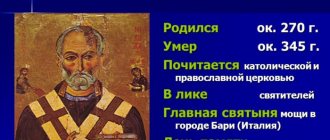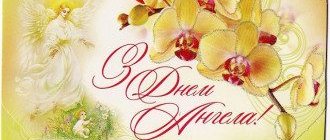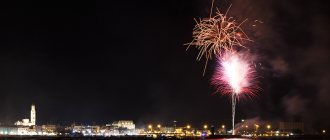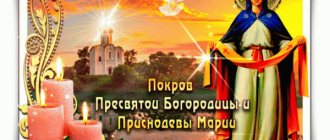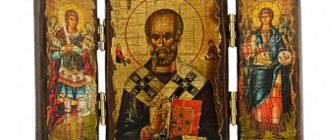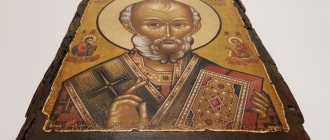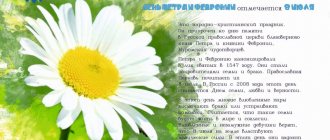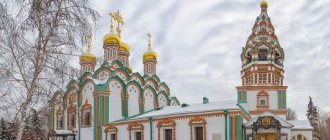Congratulations on St. Nicholas Day on May 22 are accepted not only by Nicholas, but by all Orthodox Christian believers. Indeed, on this day they remember one historical event - the transfer of the holy relics of Nicholas of Myra (the Wonderworker) from the city of Myra to the Italian city of Bari. Since then, every year at this time they celebrate St. Nicholas of the Spring (spring), glorifying this Saint. Nicholas the Wonderworker helps not only travelers, sailors, outcasts or lonely people, he helps everyone. Therefore, do not forget to honor the memory of Nikolai Ugodnik. Especially for May 22, we have prepared beautiful spring pictures and cards with congratulations on St. Nicholas Day. We invite you to download them for free and send them to your family, friends and acquaintances to remind you of this wonderful holiday - St. Nicholas the Veshny. You will also find here congratulations to Nikolai on his name day.
Happy St. Nicholas Day, May 22 - pictures with congratulations
Congratulations on St. Nicholas Day 2021
Nikolai, our saint of light, you will not abandon us or betray us. You will help in life and in everyday life, We appreciate your kindness so much. Happy Saint Nicholas Day to everyone I know. May He, as before, help us out in difficult moments under the hour.
A wonderful holiday has come to us - I congratulate you today, I wish you to find happiness on St. Nicholas Day.
Let there be many miracles, Let the world be decorated with goodness, Let there be happiness to heaven, And joy only in your family!
May Saint Nicholas protect you from various life problems, may he take away sorrows and troubles, may life not be darkened by anything.
May Saint Nicholas give you full happiness, joy, beauty, sow seeds of new life, hope, affection, light and kindness
On St. Nicholas Day, I want to wish you well, so that you receive help and support from the Saint. He will hear all your prayers, He will strengthen you in difficult times, Believe, love sincerely, He will reward you with happiness.
Saint Nicholas, heavenly miracle worker! Known for his kindness and care! He will give you joy and happiness and become your faithful guardian in your destiny! It will save you from troubles, prevent loss, teach you to laugh, hope, believe, and love and be friends to the fullest! Don't lose your guiding thread!
On St. Nicholas Day, I wish you a holy soul and endless tenderness, May only God, peace and wisdom of thought guide you correctly through life, to be in good health and spirit. I wish everyone that snow, frost and blizzards do not touch your bright home, but that peace and happiness are in it!
May the heavenly miracle worker protect you from troubles and misfortunes. He will open the right roads, reward you with success and happiness!
On the day of St. Nicholas the Wonderworker, We wish you great miracles, May your wishes come true, May happiness grow to the skies, May St. Nicholas the Saint bring great joy, And may everyone who sacredly believes in miracles be lucky!
On the day of St. Nicholas the Wonderworker, Everyone knows that dreams come true. I wish you faith and love, so that your home is full of beauty. So that everything is beautiful from the threshold, So that there is peace in everything, Let the sun shine clearly above you, Let kindness blow from your heart!
Saint Nicholas, the Wonderworker, the Pleasant, let him help and support in everything, Let him fill his soul with joy today, May his heart and home be filled with goodness and mercy. Let a word be silent before God, So that everything goes well for you, Live, radiating warmth, like a candle, Hoping for the best, believing, loving!
Happy St. Nicholas Day, I cordially congratulate you, I wish you well-being of the soul, peace in the heart! May the saint teach us to love everyone with great love, This is the surest path to perfect health! Let him teach you to live honestly, enjoy your friend’s happiness, and never remain indifferent to trouble!
Saint Nicholas the Wonderworker in Russian painting
Saint Nicholas the Wonderworker, Archbishop of Myra in Lycia (about 270–about 345), is especially loved by the Russian people. He is revered as an intercessor for all the suffering, oppressed, unjustly condemned, as the heavenly patron of travelers and sailors. Since the Baptism of Rus', many churches and icons have been dedicated to him. The image of the saint also found its place in Russian painting.
Saint Nicholas the Wonderworker. Pavlovets Nikita Ivanovich (“competent icon painter” of the Moscow Armory Chamber). 1659 Wood, gesso, tempera, fabric. 35.5 x 28.
Saint Nicholas the Wonderworker. Shebuev Vasily Kozmich. Oil on canvas, 59.5 x 46.5 cm Nizhny Novgorod State Art Museum
Nicholas the Wonderworker. Shebuev Vasily Kozmich. 1809 Oil on canvas, 55x56. State Russian Museum
* * *
Nicholas of Myra spares three innocent prisoners from death. Ilya Efimovich Repin. 1888 Oil on canvas. 215 x 196 cm State Russian Museum, St. Petersburg Inv. Zh-4001
Nicholas of Myra spares three innocent convicts from execution. Ilya Efimovich Repin. 1890 Oil on canvas. 215 x 198 cm Variant of the painting of the same name (1888, State Russian Museum) Kiev National Museum of Russian Art, Ukraine Inv. number: Ж-143
Nicholas of Myra spares three innocent convicts from the death penalty. Ilya Efimovich Repin. 1890 Paper on canvas, oil. 126 x 98 cm Kharkov Art Museum, Ukraine
The plot of the picture is connected with one of the acts of St. Nicholas the Wonderworker. While away, Nicholas of Myra learned that the secular mayor Eustathius had condemned three innocent people to execution, bribed by their ill-wishers. Wanting to stop injustice, Nicholas hastily returned to Myra and reached the Dioscuri Field, where the execution was to take place, just at the moment when the executioner was ready to begin executing the sentence. The Byzantine writer of the 10th century, Simeon Metaphrastus, described this story in the following way in “The Life and Deeds of Our Holy Father Nicholas the Wonderworker”: “When the saint saw this and turned his gaze to the sad sight, then, balancing severity with softness, he did not say either a bold or harsh word, but and showed no apprehension or timidity; As much as he could, he ran to the executioner, boldly snatched the sword from his hands, and, fearing nothing, threw it to the ground, and freed the condemned from their shackles. No one prevented his autocratic act...” It was this moment, when Nicholas the Wonderworker stops the executioner’s sword raised over the first of the condemned, that was depicted by the artist.
When creating the image of St. Nicholas the Wonderworker, the artist was guided by ancient icons, adding historically accurate details that gave it special realism, for example, the carefully painted tunic of a condemned man, the standard of a legion in the crowd. The sitters for Repin's canvas were famous cultural figures of that time. The artist partially copied the saint himself from the poet Apollo Maykov; executioner - from the artist Nikolai Kuznetsov; The writer Hieronymus Yasinsky posed for the kneeling figure, and Dmitry Merezhkovsky posed for the young man in pink.
According to the artist, the customer for the image of St. Nicholas the Wonderworker was the abbess of the St. Nicholas Convent in the village of Strelechy, Kharkov district, where he came to visit his cousin, who was a nun there. At first, Repin made a pencil sketch in the style of icon painting, but gradually became interested in this topic and after 4 years he painted a large painting, and was going to repeat it for the monastery. In 1889, the painting was exhibited at the 17th exhibition of the Wanderers Association in St. Petersburg, where it was purchased by Emperor Alexander III. In 1897, the painting was transferred from the Winter Palace to the Russian Museum of Emperor Alexander III, which was being created at that time (now the State Russian Museum), where it is still located.
In 1890, Repin painted two repetitions of this painting of the same name, in which Nicholas the Wonderworker, without touching the sword, seems to stop the executioner with his gaze. The artist donated one version for an exhibition in favor of starving peasants, held in Moscow in 1891. The painting was acquired by Fyodor Tereshchenko, and subsequently, together with other works from Tereshchenko’s collection, became part of the collection of the Kyiv Museum of Russian Art. A sketch for this repetition is kept in the State Russian Museum (canvas, oil, cardboard, 34.2 × 28.7 cm, circa 1889, inventory Zh-7907). The second, smaller version of the painting was painted for the St. Nicholas Convent in the village of Strelechy (paper on canvas, oil, 126 × 98 cm). After the monastery was closed in 1930, the icons and paintings were dismantled by local residents. Currently, the version written for the monastery is in the Kharkov Art Museum.
* * *
Queen Alexandra and Saint Nicholas the Wonderworker. Nesterov Mikhail Vasilievich. 1897 Oil on canvas. 154 x 69 cm Bashkir State Art Museum named after. M.V. Nesterova, Ufa
Saint Nicholas of Myra. Nesterov Mikhail Vasilievich. 1902-03 Fragment of the painting of the apse of the church in the name of the blessed prince Alexander Nevsky
Saint Nicholas. Mikhail Vasilievich Nesterov. 1913-1914 Cardboard, gouache. 21 x 9 cm. Sketch of the iconostasis of the Trinity Cathedral in Sumy. State Tretyakov Gallery, Moscow
Nicholas the Wonderworker. Mosaic from the workshop of the Frolov brothers based on a sketch by N.K. Bodarevsky Spas on Spilled Blood, St. Petersburg
Icon of St. Nicholas from the upper reaches of the Pinega River. Vereshchagin Vasily Vasilievich. 1894 Oil on canvas. 27.9 x 21.1. State Tretyakov Gallery
Saint Nicholas of Myra with angels. Bryullov Karl Pavlovich. Between 1843-1847 Oil on canvas, 45.2x37.5. Sketch of a group for the composition of the central dome of St. Isaac's Cathedral. State Russian Museum
Saint Nicholas of Myra with angels. Bryullov Karl Pavlovich. Between 1843-1847 Oil on canvas, 1380x1026. Sketch of a group for the composition of the central dome of St. Isaac's Cathedral. State Russian Museum
Nicholas the Wonderworker. Neff Timofey Andreevich. Between 1847 and 1850 Oil on canvas 489x212.5. State Russian Museum
Saint Nicholas the Wonderworker. Markov Alexey Tarasovich. 1849 Oil on canvas 212x89. State Russian Museum
Saint Nicholas. Roerich, Nikolai Konstantinovich (1874 - 1947). 1916 Cardboard, tempera. 70 x 105. Kiev National Museum of Russian Art, Ukraine
Congratulations to Nicholas on St. Nicholas Day
Happy St. Nicholas Day, Kolya, we. And with all our hearts we wish that your dreams come true. So that your reliable intercessor will be with you every day. And so that everything becomes possible, Whatever you ask. So that your guardian angel protects you from troubles. So that you sometimes feel His warmth and light.
Saint Nicholas, heavenly miracle worker! Known for his kindness and care! He will give you joy and happiness and become your faithful guardian in your destiny! It will save you from troubles, prevent loss, teach you to laugh, hope, believe, and love and be friends to the fullest! Don't lose your guiding thread!
May Saint Nicholas protect you from various life problems, may he take away sorrows and troubles, may life not be darkened by anything. May Saint Nicholas give you full happiness, joy, beauty, sow seeds of new life, Hope, affection, light and kindness.
Your Guardian Angel is Saint Nicholas. You honor him and remember him well: Your Saint is a miracle worker, like God. And I saved my name for you. On your birthday, we congratulate you, we wish you health and all sorts of miracles. Be, Kolenka, happy, lucky, loved and forever kept as an Angel!
I, Kolya, congratulate you on Angel’s Day, I wish him to protect you! There is no one kinder than Nikolai, Be happy, may you be lucky in your work!
May this day, which counts down the years, only leave lightness on the soul, May the rhythm of the weeks not confuse you, May your dream come true soon!
Saint Nicholas the Wonderworker, May he decorate your destiny with happiness, May you easily overcome all adversities and bring warmth to your home! It will warm you with mutual love, it will fill your wallet, it will give you wonderful health, it will relieve you from troubles and worries!
Our dear Nikolai, don’t know troubles and difficulties and live positively in this strange big world.
Appreciate what you can’t buy, Don’t stop loving life. Be kind, appreciate your friends, and don’t cough, don’t get sick.
More meetings with your friends, fewer quarrels and squabbles with enemies, more female attention and universal recognition.
I wish Kolya on his name day - You always, everywhere be a man. Don’t be ashamed of your strength, but try to show it, so that you are always lucky, so that happiness follows you, I want to wish you good luck, and no troubles.
Nikolai, I want to remind you - Your angel day has come today, Let the waves of happiness wash over you again, Let everything you asked for come true.
May you succeed in everything in life, I want to wish you luck, May luck smile soon, So that you don’t dare to lose your happiness!
Orthodox Icons
Ancient icons - the history of icon painting in Rus'
The icon is a relief pictorial image of Jesus Christ, the Mother of God or Saints.
It cannot be called a painting, since it does not reproduce what the artist has before his eyes, but a fantasy or prototype that must be taken into account. The history of icon painting goes back to ancient times and originates in early Christianity in Rus'. This art is multifaceted and unique. And it is not surprising, since it fully reflects the glorious traditions and spirituality of the Russian people. This is both a cult object for the Orthodox and a cultural national treasure.
There is no strict chronology here, however, it is generally accepted that the first icons in Rus' began to be used in the 10th century, when Christianity was adopted. Icon painting remained the center of ancient Russian culture until the 17th century, when in the era of Peter the Great it began to be supplanted by secular types of fine art. Despite the fact that Christian churches were present in Kyiv before, it was only after 988 that the first stone church was built. The painting work was carried out by specially invited masters from Byzantium. Sometimes the most important parts of her painting were carried out using the mosaic technique.
Prince Vladimir I from Chersonese brought many shrines and icons to Kyiv. Unfortunately, over the years they were lost. In addition, not a single icon of that time has survived from Chernigov, Kyiv, Smolensk and other southern cities. However, we can talk about icon painting, given the numerous wall paintings. The most ancient icons in Rus' were able to survive in Veliky Novgorod (on the territory of the St. Sophia Cathedral).
By the beginning of the 13th century, the maximum flowering of Russian icon painting was observed in the artistic center of the Vladimir-Suzdal principality. However, Batu’s invasion of Rus' had a negative impact on the further development of icon painting. The harmony characteristic of Byzantium disappeared from the icons, numerous writing techniques began to be simplified and conserved. But artistic life was not completely interrupted. Russian craftsmen continued to work in Rostov, the Russian North and Vologda. Rostov icons were characterized by significant expression, activity of images and sharpness of execution. This icon painting has always stood out for its artistry, subtlety, and refined combination of colors.
But from the end of the 14th century, the entire artistic life of Rus' was concentrated in Moscow. It was here that numerous craftsmen worked: Serbs, Russians, Greeks. Feofan the Greek himself worked in Moscow. The icons of that time were able to prepare a serious basis for the flourishing of Russian icon painting at the beginning of the 15th century, in particular the brilliant icons of Andrei Rublev. The masters paid increased attention to paints and color schemes. It is not surprising that ancient Russian icon painting is a complex and great art.
In the icons of those times, the most important place was occupied by various purple tones, shades of the sky, blue vault (they were used to depict glow, thunderstorms). Novgorod icon painting of the 15th century was able to preserve the usual love for light and bright colors. An intense and provocative sense of color was characteristic of the Pskov school. In comparison with the ringing color of Novgorod, famous tones dominate in it, with enormous moral tension in the faces of the saints. As for Rublev’s era, its main task was to revive faith in man, in his kindness and moral strength. Artists of that period tried in every possible way to convey that icon painting is an art where every detail has great meaning.
Today, Orthodox believers consider the following icons to be among the most significant:
❶ "Vladimir Mother of God"
. When turning to this icon, believers pray for deliverance from the invasions of enemies, for strengthening faith, for preserving the integrity of the country and for the reconciliation of warring parties. The history of this icon has its own roots in the distant past. It is considered to be the greatest shrine of the Russian land, which testifies to the special patronage of the Mother of God over the Russian Empire in the XIV-XVI centuries during the raids of the Tatar hordes. There is a legend that this icon was created during the life of the Mother of God herself. The modern Orthodox Church associates any of the days of the triple celebration of the icon of the Vladimir Mother of God with the deliverance of the people from enslavement through prayers that were addressed specifically to this icon.
❷ "Savior Almighty"
. This icon is often called “Savior” or “Savior”. In the iconography of Christ, this is the central image representing Him as the Heavenly King. It is for this reason that it is customary to place it at the head of the iconostasis.
❸ "Virgin Mary of Kazan"
. While turning to this icon, believers pray for healing of the disease of blindness and ask for deliverance from enemy invasions. The Kazan Mother of God is considered an intercessor in difficult times. It is used to bless young people who have decided to get married. The presented icon is also asked for happiness and family well-being. That is why it is often hung near the crib. Today, the icon of the Kazan Mother of God can be found in almost any church. The image of the Virgin Mary can also be found in most believing families. During the reign of the Romanov dynasty, such an icon was one of the most revered and important shrines, which allowed it to be considered the patroness of the royal family.
❹ "Savior Not Made by Hands"
. In accordance with church tradition, the image of the Savior was considered the first icon. There is a legend that this happened during the earthly existence of the Savior. Prince Avgar, who was the ruler of the city of Edessa, was seriously ill. Having heard about the healings that Jesus Christ performed, he wanted to look at the Savior. He sent messengers for the painter to make a portrait of Christ. But the artist failed to fulfill the assignment, because the radiance coming from the face of the Lord was so strong that the creator’s brush could not convey His Light. However, the Lord wiped His pure face with a towel, after which His Image was displayed on it. Only after receiving the image was Abgar able to be healed of his own illness. Today, people turn to the image of the savior with prayers, as well as requests for guidance on the true path, for deliverance from bad thoughts and the salvation of the soul.
❺ Icon of St. Nicholas the Wonderworker
. Nicholas the Wonderworker is known as the patron saint of all who are constantly on the move - pilots, fishermen, travelers and sailors, and is the most revered saint throughout the world. In addition, he is the intercessor of those who have been unjustly offended. He patronizes children, women, innocent prisoners and the poor. Icons with his image are the most common in modern Orthodox churches.
Seven-shot icon of the Mother of God
The history of the discovery of this icon goes back far into the past. It is believed that about four hundred years ago it was found on one of the bell towers of the Church of the Holy Apostle John the Theologian in the Vologda region. Then, a peasant who had long suffered from lameness saw a dream in which he had a long-awaited cure for his illness. A divine voice in a dream told him that if he prayed near the icon of the Most Holy Theotokos, the illness would leave him; the location of this shrine was also revealed to him.
Twice the peasant came to the bell tower at the local church and told about his dream, but no one then believed his stories. Only the third time, after much persuasion, was the sufferer allowed into the belfry. Imagine the surprise of the local residents, the ministers of the Church, when on the stairs, instead of one of the steps, an icon was discovered, which everyone took for an ordinary perch. It looked like a canvas pasted onto an ordinary wooden board. They washed it from dust and dirt, restored it as much as possible, and then held a prayer service to the Seven Shore Mother of God. After this, the peasant was healed of a painful illness, and the icon began to be revered by the clergy along with the rest. So, in 1830, cholera raged in the Vologda province, claiming the lives of many thousands of people. Believing local residents held a religious procession around the settlement, together with the icon, performing a prayer service to the Most Holy Theotokos. After some time, the number of cases began to decline, and then the scourge completely left this city forever.
After this incident, the icon commemorated many more truly miraculous healings. However, after the revolution of the seventeenth year, the Church of the Holy Apostle John the Theologian, where the icon was located, was destroyed, and the icon itself disappeared. Currently, the myrrh-streaming Icon of the Seven-Shot Mother of God is located in Moscow at the Church of the Archangel Michael.
The image of the Mother of God itself is quite interesting. Usually on all icons She appears with the Savior in her arms, or with angels and saints, but here the Mother of God is depicted completely alone, with seven swords stuck into Her heart. This image symbolizes Her severe suffering, indescribable grief and deep sadness for her Son during her time on earth. And this icon was written based on the prophecy of the holy righteous Simeon, given in Scripture.
There is an opinion of some clergy that the seven arrows piercing the chest of the Virgin Mary personify the seven most important human passions, sinful vices. There is also an opinion that the seven arrows are the seven holy Sacraments.
It is customary to pray in front of this icon to appease evil hearts, in times of disease epidemics; they also pray for the military, paying their debt to the Motherland, so that the enemy’s weapon will bypass them. The person praying seems to forgive the insults of his enemies and asks for the softening of their hearts.
The day of veneration of the Icon of the Seven-Shot Mother of God is considered to be August 13 according to the new style or August 26 according to the old one. During prayer, it is desirable that at least seven candles be lit, but this is not necessary. At the same time, the prayer of the Long-Suffering Mother of God and the Troparion are read.
At home, a specific location of the icon is not prescribed, so it can be located either on the iconostasis or in any other place, for example, on the wall at the entrance to the main room. However, there are several tips for its location: it should not hang or stand near the TV, there should not be any photographs or images or posters around it.
The seven-shot image is a reflection of the gospel narrative of the arrival of the Virgin Mary and the Child Jesus in the Jerusalem Temple on the 40th day after His birth. The holy elder Simeon, who served in the temple, saw in the Baby the Messiah expected by all and predicted trials and suffering for Mary that would pierce her heart like a weapon.
The Seven Shot Icon depicts the Mother of God alone, without the Child Jesus. Seven swords or arrows piercing her heart (four swords on the left, three on the right) are a symbol of the sorrows that the Mother of God endured in her earthly life. The weapon itself, symbolically depicted with seven swords, means the unbearable mental anguish and sorrow that the Virgin Mary experienced during the hours of torment on the cross, crucifixion and death on the cross of Her son.
According to the Holy Scriptures, the number seven symbolizes the completeness of something: seven deadly sins, seven cardinal virtues, seven church sacraments. The image of seven swords is not accidental: the image of a sword is associated with the shedding of blood.
This icon of the Mother of God has another version of the iconography - “Simeon’s Prophecy” or “Tenderness of Evil Hearts”, where seven swords are located on both sides, three in number and one in the center.
The miraculous icon of the Mother of God of Seven Arrows is of North Russian origin, associated with her miraculous appearance. Until 1917, she stayed in the Church of St. John the Evangelist near Vologda.
There is a legend about her miraculous discovery. A certain peasant, who had been seriously suffering from an incurable lameness for many years and was praying for healing, received a Divine voice. He ordered him to find the image of the Mother of God among the old icons that were kept in the bell tower of the Theological Church and to pray to him for healing. The icon was found on the stairs of the bell tower, where it served as a step like a simple board covered with dirt and debris. The clergy cleaned the image and served a prayer service in front of it, and the peasant was healed.
Before the image of the Seven-Shot Mother of God, they pray for the pacification of those at war, for acquiring the gift of patience in the face of embitterment of the heart, in the face of enmity and persecution.
The celebration of the icon takes place on August 26 and on the Presentation of the Lord on February 15.
Icon of St. Archangel Michael
Michael is considered a very important person in the heavenly hierarchy; the word Archangel means “leader of the angels.” He is the main leader among the angels. The name Michael means "one who is like God."
Archangels have always been considered warriors and protectors of Heaven. Of course, the main patron and defender of the Christian faith is the great Archangel Michael. It is worth noting that the Holy Archangel Michael is one of the most famous angels, he is also called the Archangel, which means that he is the most important of all ethereal forces.
According to the Holy Scriptures and tradition, he always stood up for humanity and will always continue to serve as one of the main defenders of the faith. In front of icons with Archangel Michael, people ask for protection from enemy invasion, civil war, and for the defeat of opponents on the battlefield.
The Council of Michael and all the ethereal powers of heaven is celebrated on November 21, and on September 19 the miracle of the Archangel in Colossae is celebrated. References to Michael can first be seen in the Old Testament, although Michael is not mentioned by name in the text, but it was said that Joshua “looked up and saw a man standing before him with a sword drawn in his hand.”
In the book of Daniel, Michael appears alongside the Archangel Gabriel to help defeat the Persians. In a later vision, she told Danil that “at that time (the end of time) Michael, the Great Prince, will protect the people. A difficult time will come, such as has not been seen since the beginning of time...” Thus, it can be understood that Michael plays a key role as the defender of Israel, her chosen people, and the Church.
The Church Fathers also attribute the following event to Michael: During the Exodus of the Israelites from Egypt, he walked ahead of them, in the form of a pillar of cloud during the day, and at night in the form of a pillar of fire. The power of the great commander-in-chief was manifested in the destruction of 185 thousand soldiers of the Assyrian emperor Sennacherib, also the wicked leader Heliodorus.
It is worth mentioning that there are many miraculous cases associated with Archangel Michael, the protection of three young men: Ananias, Azariah and Misail, who were thrown into a hot furnace for refusing to bow to the idol. By the will of God, the commander-in-chief Archangel Michael transports the prophet Habakkuk from Judea to Babylon to give food to Daniel in the lions' den. Archangel Michael argued with the devil over the body of the holy prophet Moses.
In New Testament times, Saint Archangel Michael showed his power when he miraculously saved a young man who was thrown into the sea by robbers with a stone around his neck on the shores of Mount Athos. This story is found in the Athos Patericon, from the life of St. Neophytos.
Perhaps the most famous miracle associated with the great Saint Michael the Archangel is the salvation of the church at Colossae. A number of pagans tried to destroy this church by directing the flow of two rivers directly towards it. The Archangel appeared among the waters, and, carrying the cross, directed the rivers underground, so that the church remained standing on the earth and was not destroyed thanks to Michael. In the spring, the water of these rivers after this miracle event is said to have healing powers.
Russian people revere Archangel Michael along with the Mother of God. The Most Pure Mother of God and Michael are always mentioned in church hymns. Many monasteries, cathedrals, churches are dedicated to the commander-in-chief of the heavenly forces, St. Archangel Michael. There was no city in Rus' where there was no church or chapel dedicated to Archangel Michael.
On icons, Michael is often depicted holding a sword in his hand, and in the other he holds a shield, spear, or white banner. Some icons of Archangel Michael (or Archangel Gabriel) show angels holding an orb in one hand and a staff in the other.
Icon of the Kazan Mother of God
The most widespread and revered Orthodox icons in Rus' are the icons of the Mother of God. Tradition says that the first image of the Mother of God was created by the Evangelist Luke during the life of the Mother of God; she approved of the icon and imparted her strength and grace to it. In the Russian Orthodox Church there are about 260 images of the Mother of God, glorified by miracles. One of these images is the icon of the Kazan Mother of God.
According to iconography, this image belongs to one of the main six iconographic types, which is called “Hodegetria” or “Guide”. The Old Russian version of this icon, painted by an icon painter monk in the image of the Byzantine Hodegetria, is distinguished by its warmth, softening the regal bearing of the original from Byzantium. The Russian Hodegetria has not a waist-length, but a shoulder-length image of Mary and the Infant Jesus, thanks to which their faces seem to come close to those praying.
In Russia there were three main miraculous icons of the Kazan Mother of God. The first icon is a prototype miraculously revealed in 1579 in Kazan, which was kept in the Kazan Mother of God Monastery until 1904 and was lost. The second icon is a copy of the Kazan image and was presented to Ivan the Terrible. Later, this icon of the Mother of God was transported to St. Petersburg and transferred to the Kazan Cathedral during its illumination on September 15, 1811. The third icon of the Kazan Mother of God is a copy of the Kazan prototype, was transferred to the militia of Minin and Pozharsky and is now kept in Moscow in the Epiphany Cathedral.
In addition to these main icons of the Kazan Mother of God, a large number of her miraculous lists were made. Prayer in front of this image helps in all human sorrows, sorrows and adversities. Russian people always prayed to her to protect their native land from foreign enemies. The presence of this icon in the house protects its household from all troubles; it shows, like a Guide, the right path in making difficult decisions. In front of this image, the Mother of God is prayed for eye diseases. According to legend, during the miraculous discovery of the prototype in Kazan, a miracle of insight occurred from the blindness of the beggar Joseph, who had been blind for three years. This icon is used to bless the newlyweds for marriage so that it will be strong and long.
The celebration of the Kazan Icon of the Mother of God takes place twice a year: in honor of the acquisition of the image on July 21 and in honor of the liberation of Rus' from the Polish intervention on November 4.
Iveron Icon of the Mother of God
The Iveron Icon of the Mother of God, revered in Rus' as miraculous, is a copy of the oldest image, which is kept in the Iveron Monastery in Greece on Mount Athos and dates back to the 11-12th century. According to the iconographic type, she is Hodegetria. According to the legend, the icon of the Mother of God, saved from the iconoclasts during the reign of Emperor Theophilus (9th century), miraculously appeared to the Iberian monks. They placed her in the gate church and named her Portaitissa or Goalkeeper.
In this version of the Hodegetria, the face of the Virgin Mary is turned and inclined towards the Child Jesus, who is presented in a slight turn towards the Virgin Mary. The Virgin Mary has a bleeding wound on her chin, which, according to legend, was inflicted on the image by opponents of the icons.
The miraculous image was well known in Rus'. During the reign of Alexei Mikhailovich, the monks of the Iversky Monastery made a copy of the prototype and delivered it to Moscow on October 13, 1648. In the 17th century. The Iveron Mother of God was especially revered in Rus'.
The Iveron Icon of the Most Holy Theotokos helps repentant sinners find the path and strength to repentance; relatives and friends pray for the unrepentant. The image protects the house from attacks by enemies and natural disasters, from fire, and heals from physical and mental illnesses.
The celebration of the Iveron Icon is held on February 25 and October 26 (the arrival of the icon from Athos in 1648).
Icon of the Intercession of the Virgin Mary
The icon of the Intercession of the Theotokos is dedicated to the great church holiday in Russian Orthodoxy - the Intercession of the Blessed Virgin Mary. In Rus', the word “pokrov” means veil and protection. On the day of celebration, October 14, Orthodox people pray to the Heavenly Intercessor for protection and help.
The Intercession Icon depicts the miraculous appearance of the Mother of God, which occurred in the 10th century in the Blachernae Church of Constantinople, besieged by enemies. During the all-night prayer, Blessed Andrei saw the miraculous appearance of the Mother of God surrounded by angels, apostles and prophets. The Mother of God took off the veil from her head and spread it over those praying.
Two centuries later, in the 14th century. In honor of this holy event in Rus', a divine service was compiled, the main idea of which was the unity of the Russian people under the Protection of the Most Holy Theotokos, for whom the Russian land is Her earthly destiny.
There were two main types of icons of the Intercession: Central Russian and Novgorod. In Central Russian iconography, which corresponds to the vision of Blessed Andrew, the Mother of God herself bears the veil. On Novgorod icons, the Mother of God appears in the image of Oranta, and the veil is held and extended over her by angels.
Prayer before the image of the Intercession of the Mother of God helps in everything, if the thoughts of the person praying are good and pure. The image helps to overcome our external and internal enemies; it is a spiritual shield not only over our heads, but also over our souls.
Icon of St. Nicholas the Wonderworker
Among the numerous icons of saints in Orthodoxy, one of the most beloved and revered by believers is the image of St. Nicholas the Pleasant. In Rus', after the Mother of God, this is the most revered saint. In almost every Russian city there is a St. Nicholas Church, and the icon of St. Nicholas the Wonderworker is in every Orthodox church in the same area as the images of the Mother of God.
In Rus', the veneration of the saint begins with the adoption of Christianity; he is the patron saint of the Russian people. Often in icon painting he was depicted on the left hand of Christ, and the Mother of God on the right.
Saint Nicholas the Pleasant lived in the 4th century. From a young age he served God, later becoming a priest, and then archbishop of the Lycian city of Myra. During his lifetime, he was a great shepherd who gave consolation to all those who mourned and led the lost to the truth.
Prayer in front of the icon of St. Nicholas the Pleasant protects from all misfortunes and helps in solving all sorts of problems. The image of St. Nicholas the Wonderworker protects those traveling by land and sea, protects the innocently convicted, those who are threatened with a needless death.
Prayer to St. Nicholas heals from illnesses, helps in enlightening the mind, in the successful marriage of daughters, in ending civil strife in the family, between neighbors, and military conflicts. Saint Nicholas of Myra helps in the fulfillment of wishes: it is not for nothing that he was the prototype of Father Frost, who fulfills Christmas wishes.
The Day of Remembrance of St. Nicholas the Pleasant is celebrated three times a year: on May 22, spring St. Nicholas (the transfer of the saint’s relics to Bari in Italy to avoid their desecration by the Turks), on August 11 and December 19 – winter St. Nicholas.
"Russian icons in high resolution." Creation of the album: Andrey (zvjaginchev) and Konstantin (koschey).
Pictures-congratulations on the day of St. Nicholas the Wonderworker
See also Congratulations on the Day of St. Nicholas the Wonderworker in verses and pictures.
